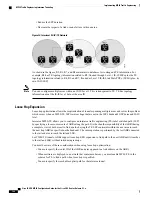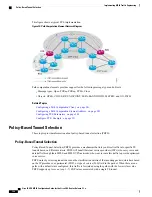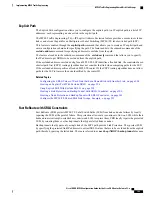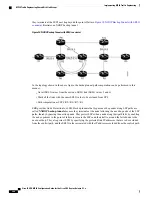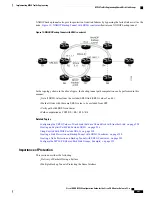
Point-to-Multipoint Fast Reroute
MPLS-TE Fast Reroute (FRR) is a mechanism to minimize interruption in traffic delivery to a TE Label
Switched Path (LSP) destination as a result of link failures. FRR enables temporarily fast switching of LSP
traffic along an alternative backup path around a network failure, until the TE tunnel source signals a new
end-to-end LSP.
Both Point-to-Point (P2P) and P2MP-TE support only the Facility FRR method from RFC 4090.
P2P LSPs are used to backup P2MP S2L ( source 2 Leaf ). Only link and bandwidth protection for P2MP S2Ls
are supported. Node protection is not supported.
MPLS-TE link protection relies on the fact that labels for all primary LSPs and subLSPs are using the MPLS
global label allocation. For example, one single (global) label space is used for all MPLS-TE enabled physical
interfaces on a given MPLS LSP.
Related Topics
Point-to-Multipoint Traffic-Engineering Overview, on page 193
Point-to-Multipoint RSVP-TE , on page 195
Point-to-Multipoint Label Switch Path
The Point-to-Multipoint Label Switch Path (P2MP LSP) has only a single root, which is the Ingress Label
Switch Router (LSR). The P2MP LSP is created based on a receiver that is connected to the Egress LSR. The
Egress LSR initiates the creation of the tree (for example, tunnel grafting or pruning is done by performing
an individual sub-LSP operation) by creating the Forwarding Equivalency Class (FEC) and Opaque Value.
Grafting and pruning operate on a per destination basis.
Note
The Opaque Value contains the stream information that uniquely identifies the tree to the root. To receive
label switched multicast packets, the Egress Provider Edge (PE) indicates to the upstream router (the next
hop closest to the root) which label it uses for the multicast source by applying the label mapping message.
The upstream router does not need to have any knowledge of the source; it needs only the received FEC to
identify the correct P2MP LSP. If the upstream router does not have any FEC state, it creates it and installs
the assigned downstream outgoing label into the label forwarding table. If the upstream router is not the root
of the tree, it must forward the label mapping message to the next hop upstream. This process is repeated
hop-by-hop until the root is reached.
By using downstream allocation, the router that wants to receive the multicast traffic assigns the label for it.
The label request, which is sent to the upstream router, is similar to an unsolicited label mapping (that is, the
upstream does not request it). The upstream router that receives that label mapping uses the specific label to
send multicast packets downstream to the receiver. The advantage is that the router, which allocates the labels,
does not get into a situation where it has the same label for two different multicast sources. This is because it
manages its own label space allocation locally.
Path Option for Point-to-Multipoint RSVP-TE
P2MP tunnels are signaled by using the dynamic and explicit path-options in an IGP intra area. InterArea
cases for P2MP tunnels are signaled by the verbatim path option.
Cisco IOS XR MPLS Configuration Guide for the Cisco CRS Router, Release 5.1.x
196
Implementing MPLS Traffic Engineering
Point-to-Multipoint Traffic-Engineering

